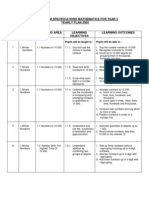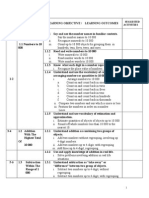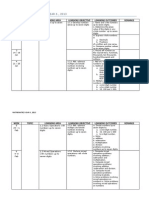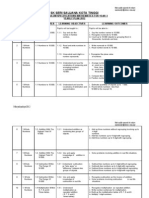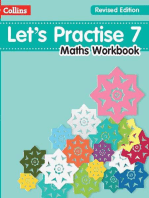Mathematics Yearly Plan (Year 5) 2010: WE EK Topic / Learning Areas Learning Objectives / Learning Outcome Remarks
Mathematics Yearly Plan (Year 5) 2010: WE EK Topic / Learning Areas Learning Objectives / Learning Outcome Remarks
Uploaded by
Moorsyidee MokhtaruddinCopyright:
Available Formats
Mathematics Yearly Plan (Year 5) 2010: WE EK Topic / Learning Areas Learning Objectives / Learning Outcome Remarks
Mathematics Yearly Plan (Year 5) 2010: WE EK Topic / Learning Areas Learning Objectives / Learning Outcome Remarks
Uploaded by
Moorsyidee MokhtaruddinOriginal Title
Copyright
Available Formats
Share this document
Did you find this document useful?
Is this content inappropriate?
Copyright:
Available Formats
Mathematics Yearly Plan (Year 5) 2010: WE EK Topic / Learning Areas Learning Objectives / Learning Outcome Remarks
Mathematics Yearly Plan (Year 5) 2010: WE EK Topic / Learning Areas Learning Objectives / Learning Outcome Remarks
Uploaded by
Moorsyidee MokhtaruddinCopyright:
Available Formats
MATHEMATICS YEARLY PLAN (YEAR 5) 2010
WE EK 1 /2 TOPIC / LEARNING AREAS
1. WHOLE NUMBER
LEARNING OBJECTIVES / LEARNING OUTCOME
1.1.1 Develop number sense up to 1 000 000. i. Name and write numbers up to 1 000 000. ii. Determine the place value of the digits in any whole number up to 1 000 000. iii. Compare value of numbers up to 1 000 000. iv. Round off numbers to the nearest tens, hundreds, thousands, ten thousands and hundred thousands. 1.2.1 Add numbers to the total of 1 000 000. i. Add any two to four numbers up to 1 000 000. ii. Solve addition problems. 1.3.1 Subtract numbers from a number less than 1 000 000. i. Subtract one number from a bigger number less than 1 000 000. ii. Subtract successively from a bigger number less than 1 000 000. iii. Solve subtraction problems. 1.4.1 Multiply any two numbers with the highest product of 1 000 000. i. Multiply up to five digit numbers with a one-digit number, a two-digit number, 10, 100 and 1000. ii. Solve problems involving multiplication. 1.5.1 Divide a number less than1 000 000 by a two-digit number. i. Divide numbers up to six digits by one-digit number, 10, 100 and 1000, two-digit number, ii. Solve problems involving division. 1.6.1 Perform mixed operations involving multiplication and division. i. Calculate mixed operation on whole numbers involving multiplication and division.
REMARKS
1.1 Numbers to 1 000 000
1.2 Addition with the highest total of 1 000 000
1.3 Subtraction within the range of 1 000 000
1.4 Multiplication with the highest product of a. 1 000 000 b.
c.
1.5 Division with the highest dividend of 1 000 000
a. b. c.
1.6 Mixed operations
1 Mathematics Yearly Plan (Year 5)
WE EK
TOPIC / LEARNING AREAS
LEARNING OBJECTIVES / LEARNING OUTCOME
ii. Solve problems involving mixed operations of division and multiplication.
REMARKS
2. FRACTIONS 2.1 Improper fractions
2.1.1
Understand improper fractions. i. Name and write improper fractions with denominators up to 10. ii. Compare the value of the two improper fractions.
2.2
Mixed numbers
2.2.1
Understand mixed numbers. i. Name and write mixed numbers with denominators up to 10. ii. Convert improper fractions to mixed numbers and vice-versa.
2.3
Addition of fractions
2.3.1 Add two mixed numbers. i. Add two mixed numbers with the same denominators up to 10. ii. Add two mixed numbers with different denominators up to 10. iii. Solve problems involving addition of mixed numbers. 2.4.1 Subtract mixed numbers. i. Subtract two mixed numbers with the same denominator up to 10. ii. Subtract two mixed numbers with different denominators up to 10. iii. Solve problems involving subtraction of mixed numbers. 2.5.1 Multiply any proper fractions with a whole number up to 1 000 i. Multiply whole numbers with proper fractions. ii. Solve problems involving multiplication of fractions .
2.4
Subtraction of fractions
2.5
Multiplication of fractions
UJIAN BULANAN 1
( 23 Feb - 25 Feb ) Revision Correction
3. DECIMALS 3.1 Decimal numbers
3.1.1 Understand and use the vocabulary related to decimals. i. Name and write decimal numbers to three decimal places. ii. Recognise the place value of
2 Mathematics Yearly Plan (Year 5)
WE EK
TOPIC / LEARNING AREAS
LEARNING OBJECTIVES / LEARNING OUTCOME
thousandths. iii. Convert fractions of thousandths to decimal numbers and vice versa. iv. Round off decimal numbers to the nearest tenths, hundredths.
REMARKS
a. b.
10
3.2
Addition of decimal numbers
3.2.1 Add decimal numbers up to three decimal places. i. Add any two to four decimal numbers up to three decimal places involving a. decimal numbers and decimal numbers, b. whole numbers and decimal numbers, ii. Solve problems involving addition of decimal numbers. 3.3.1 Subtract decimal numbers up to three decimal places. i. Subtract a decimal number from another decimal up to three decimal places. ii. Subtract successively any two decimal numbers up to three decimal places. iii. Solve problems involving subtraction of decimal numbers. 3.4.1 Multiply decimal numbers up to three decimal places with a whole number. i. Multiply any decimal numbers up to three decimal places with a one-digit number, a two-digit number, 10, 100 and 1000. ii. Solve problems involving multiplication of decimal numbers. 3.5.1 Divide decimal numbers up to three decimal places by a whole number i. Divide a whole number by 10 100 1 000 ii. Divide a whole number by a one-digit number, a two-digit whole number, iii. Divide a decimal number of three decimal places by
10
3.3
Subtraction of decimal numbers
11
3.4
Multiplication of decimal numbers
a. b. c.
12
3.5
Division of decimal numbers a. b. c. a. b.
3 Mathematics Yearly Plan (Year 5)
WE EK
TOPIC / LEARNING AREAS
a. b. c. d.
LEARNING OBJECTIVES / LEARNING OUTCOME
a one-digit number, a two-digit whole number, 10, 100. iv. Solve problem division of decimal numbers.
REMARKS
involving
13
4. PERCENTAGE 4.1 Percentage
4.1.1 Understand and use percentage. i. Name and write the symbol for percentage. ii. State fraction of hundredths in percentage. iii. Convert fraction of hundredths to percentage and vice versa. 4.2.1 Relate fractions and decimals to percentage i. Convert proper fractions of tenths to percentage. ii. Convert proper fractions with the denominators of 2, 4, 5, 20, 25 and 50 to percentage. iii. Convert percentage to fraction in its simplest form. iv. Convert percentage to decimal number and vice versa. 5.1.1 Understand and use the vocabulary related to money. i. Read and write the value of money in ringgit and sen up to RM100 000. 5.1.2 Use and apply mathematics concepts when dealing with money up to RM100 000. i. Add money in ringgit and sen up to RM100 000. ii. Subtract money in ringgit and sen within the range of RM100 000. iii. Multiply money in ringgit and sen with a whole number, fraction or decimal with products within RM100 000. iv. Divide money in ringgit and sen with the dividend up to RM100 000. v. Perform mixed operation of multiplication and division involving money in ringgit and sen up to RM100 000. vi. Solve problems in real context involving money in ringgit and sen up to
14
4.2
Convert fractions and decimal to percentage
1516
5. MONEY 5.1 Money to RM100 000
4 Mathematics Yearly Plan (Year 5)
WE EK 1718
TOPIC / LEARNING AREAS
6. TIME 6.1 Reading and writing time
LEARNING OBJECTIVES / LEARNING OUTCOME
RM100 000. 6.1.1 time. Understand the vocabulary related to
REMARKS
i. Read and write time in the 24-hour system. ii. Relate the time in the 24-hour system to the 12-hour system. iii. Convert time from the 24hour system to the 12-hour system and vice-versa. 6.2.1 Understand the relationship between units of time. i. Convert time in fractions and decimals of a minute to seconds. ii. Convert time in fractions and decimals of an hour to minutes and to seconds. iii. Convert time in fractions and decimals of a day to hours, minutes and seconds. iv. Convert units of time from century to years and vice versa. century to decades and vice versa. PKSR 1 ( 18 Mei - 20 Mei ) Revision Correction
6.2
Relationship between units of time
a. b.
19
20
6.3
Basic operations involving time
6.3.1 Add, subtract, multiply and divide units of time. i. Add time in hours, minutes and seconds. ii. Subtract time in hours, minutes and seconds. iii. Multiply time in hours, minutes and seconds. iv. Divide time in hours, minutes and seconds. 6.4.1 Use and apply knowledge of time to find the duration. i. Identify the start and end times of an event. ii. Calculate the duration of an event, involving hours, minutes and seconds. days and hours. iii. Determine the start or end time of an event from a given duration of time. iv. Solve problems involving time
21
6.4
Duration
a. b.
5 Mathematics Yearly Plan (Year 5)
WE EK
TOPIC / LEARNING AREAS
LEARNING OBJECTIVES / LEARNING OUTCOME
duration in fractions and/or decimals of hours, minutes and seconds.
REMARKS
22
7. LENGTH 7.1 Measuring length
7.1.1
Measure and compare distances. i. Describe by comparison the distance of one kilometre. ii. Measure using scales for distance between places.
22
7.2
Relationship between units of length
7.2.1 Understand the relationship between units of length. i. Relate metre and kilometre. ii. Convert metre to kilometre and vice versa.
23
7.3
Basic operations involving length
a. b.
a. b.
7.3.1 Add, subtract, multiply and divide units of length. i. Add and subtract units of length involving conversion of units in kilometres, kilometres and metres. ii. Multiply and divide units of length in kilometres involving conversion of units with a one-digit number, 10, 100, 1 000. iii. Solve problems involving basic operations on length. Compare mass of objects. i. Measure and record masses of objects in kilograms and grams. ii. Compare the masses of two objects using kilogram and gram, stating the comparison in multiples or fractions. iii. Estimate the masses of objects in kilograms and grams. 8.1.2 Understand the relationship between units of mass. i. Convert units of mass from fractions and decimals of a kilogram to grams and vice versa. ii. Solve problems involving conversion of mass units in fraction and/or decimals. 8.1.1
24
8. MASS 8.1 Comparing mass
Third Monthly Test ( 27 29 July 09)
25
26
9. VOLUME OF LIQUID 9.1 Comparing volume
9.1.1 Measure and compare volumes of liquid using standard units i. Measure and record the volumes of liquid in a smaller metric unit given the measure in fractions and/or decimals of a larger unit. ii. Estimate the volumes of liquid
6 Mathematics Yearly Plan (Year 5)
WE EK
TOPIC / LEARNING AREAS
LEARNING OBJECTIVES / LEARNING OUTCOME
involving fractions and decimals in litres and mililitres. iii. Compare the volumes of liquid involving fractions and decimals using litres and mililitres.
REMARKS
26
9.2
Relationship between units of volume
9.2.1 Understand the relationship between units of volume of liquid i. Convert unit of volumes involving fractions and decimals in litres and vice-versa. ii. Solve problem involving volume of liquid.
27
UJIAN BULANAN 2 ( 27 JULAI - 29 JULAI ) Revision Correction 9.3 Operations on volume of liquid 9.3.1 Add and subtract units of volume. i. Add units of volume involving mixed decimals in a. litres, b. mililitres, c. litres and mililitres. ii. Subtract units of volume involving mixed decimals in litres, mililitres, litres and mililitres.
28
a. b. c.
29 9.3.2 Multiply and divide units of volume. i. Multiply units of volume involving
a. b. units. mixed number using: a one-digit number, 10, 100, 1000, involving conversion of
ii. Divide units of volume using
a. b. up to 2 digit number, 10, 100, 1000, involving decimals. iii. Divide unit of volume using: mixed
7 Mathematics Yearly Plan (Year 5)
WE EK
TOPIC / LEARNING AREAS
a. b.
LEARNING OBJECTIVES / LEARNING OUTCOME
a one-digit number, 10, 100, 1000, involving conversion of units. iv. Solve problems computations for volume of liquids.
REMARKS
involving
3031
10. SHAPE AND SPACE 10.1 Composite twodimensional shapes a. b. c. d. e.
a. b. c. d. e. f.
10.1.1 Find the perimeter of composite 2-D shapes i. Measure the perimeter of the following composite 2-D shapes. square and square, rectangle and rectangle, triangle and triangle, square and rectangle, square and triangle, rectangle and triangle. ii. Calculate the perimeter of the following composite 2-D shapes. square and square, rectangle and rectangle, triangle and triangle, square and rectangle, square and triangle, rectangle and triangle. iii. Solve problems involving perimeters of composite 2-D shapes. 10.1.2 Find the area of composite 2-D shapes. i. Measure the area of the following composite 2-D shapes. square and square, rectangle and rectangle, square and rectangle, ii. Calculate the area of the following composite 2-D shapes. square and square, rectangle and rectangle,
32
a. b. c.
a. b.
8 Mathematics Yearly Plan (Year 5)
WE EK
TOPIC / LEARNING AREAS
c.
LEARNING OBJECTIVES / LEARNING OUTCOME
square and rectangle, iii. Solve problems involving areas of composite 2-D shapes. 10.2.1 Find the volume of composite 3-D shapes. i. Measure the volume of the following composite 3-D shapes. cube and cube, cuboid and cuboid cube and cuboid. ii. Calculate the volume of the composite 3-D shapes following. cube and cube, cuboid and cuboid, cuboid and cuboid iii. Solve problems involving perimeters of composite 3-D shapes.
REMARKS
3334
10.2 Composite threedimensional shapes a. b. c.
a. b. c.
35
11. DATA HANDLING 11.1 Average
11.1.1 Understand and use the vocabulary related to average. i. Describe the meaning of average. ii. State the average of two or three quantities. iii. Determine the formula for average. 11.1.2 Use and apply knowledge of average. i. Calculate the average using formula. ii. Solve problem in real life situation.
36
11.2 Organising and interpreting data
11.2.1 Understand the vocabulary relating to data organisation in graphs. i. Recognise frequency, mode, range, maximinum and minimum value from bar graphs. 11.2.2 Organise and interpret data from tables and charts i. Construct a bar graph from a given set of data. ii. Determine the frequency, mode, range, average, maximum and minimum value from a given graph
9 Mathematics Yearly Plan (Year 5)
WE EK
TOPIC / LEARNING AREAS
LEARNING OBJECTIVES / LEARNING OUTCOME
REMARKS
3739 40
Revision for PKSR 2 PKSR 2 ( 1 Nov - 4 Nov 2010 ) Marking exam paper Correction Quality Day
4142
10 Mathematics Yearly Plan (Year 5)
You might also like
- Rancangan Tahunan Math Tahun 5 2012 MS Excell Shared by AzyDocument13 pagesRancangan Tahunan Math Tahun 5 2012 MS Excell Shared by AzyTravis MonroeNo ratings yet
- Week Topic / Learning Area Learning Objective / Learning Outcomes Suggested Activities 1 Whole NumbersDocument11 pagesWeek Topic / Learning Area Learning Objective / Learning Outcomes Suggested Activities 1 Whole NumbersGane GanesanNo ratings yet
- Maths Year 5Document9 pagesMaths Year 5Nurul KikinNo ratings yet
- Yearly Plan MathsDocument8 pagesYearly Plan MathsTasaratha Rajan AnamalaiNo ratings yet
- Topic Learning Area Learning Objectives Learning Outcomes: Yearly Plan Mathematics Year 5Document19 pagesTopic Learning Area Learning Objectives Learning Outcomes: Yearly Plan Mathematics Year 5ranj19869No ratings yet
- RPT MT Y5 2012Document9 pagesRPT MT Y5 2012Ani HaniNo ratings yet
- Rancangan Tahunan Matematik Tahun 5 2013Document8 pagesRancangan Tahunan Matematik Tahun 5 2013Nurulnaim OmarNo ratings yet
- RPT Mat Year 6Document6 pagesRPT Mat Year 6Kayalvile Vijaya KumarNo ratings yet
- Mathematics Yearly Plan (Year 6) Sk. Kem Terendak 1 Encik Ramli Bin BabaDocument4 pagesMathematics Yearly Plan (Year 6) Sk. Kem Terendak 1 Encik Ramli Bin BabaFaridah Binti KamaludinNo ratings yet
- RPT & Plan-J Math Year 5 2012Document26 pagesRPT & Plan-J Math Year 5 2012sapuanazianNo ratings yet
- Rancangan Tahunan MatematikDocument19 pagesRancangan Tahunan MatematikHailmi OthmanNo ratings yet
- RPT Math Tahun 4 2013Document11 pagesRPT Math Tahun 4 2013Preloved BoutiqeuNo ratings yet
- Rancangan Tahunan Matematik Tahun 5 - 2012Document8 pagesRancangan Tahunan Matematik Tahun 5 - 2012mrdan100% (1)
- Mathematics Yearly Plan (Year Six) : 1. Whole NumbersDocument3 pagesMathematics Yearly Plan (Year Six) : 1. Whole NumbersRamziah BongsuNo ratings yet
- Rpt&Plan-j Math Year 4Document27 pagesRpt&Plan-j Math Year 4Kee SekKhaiNo ratings yet
- RPT: Mathematics Year 5Document20 pagesRPT: Mathematics Year 5man_zero1984No ratings yet
- RPT & Plan-J Math Year 5 2010Document20 pagesRPT & Plan-J Math Year 5 2010Zoe KooNo ratings yet
- Matematik Tahun 4Document10 pagesMatematik Tahun 4tanwlbmNo ratings yet
- Mathematics Yearly Plan (Year 4)Document9 pagesMathematics Yearly Plan (Year 4)Mhreal PetronasNo ratings yet
- MT Yearly Plan Year 1 6Document6 pagesMT Yearly Plan Year 1 6abusufian80No ratings yet
- Mathematics Yearly Plan (Year 5) : Week Topic / Learning Areas Learning Objectives / Learning Outcome RemarksDocument8 pagesMathematics Yearly Plan (Year 5) : Week Topic / Learning Areas Learning Objectives / Learning Outcome RemarksMhreal PetronasNo ratings yet
- Mathematics Yearly Plan (Year Six) : 1. Whole NumbersDocument3 pagesMathematics Yearly Plan (Year Six) : 1. Whole NumbersAdemizan AhadNo ratings yet
- Year3 Mat HSPDocument8 pagesYear3 Mat HSPShazwani HamzahNo ratings yet
- Yearly Plan Y4 2012Document13 pagesYearly Plan Y4 2012Fauzia AngelNo ratings yet
- Year3 Mat HSPDocument8 pagesYear3 Mat HSPyuslinaaNo ratings yet
- Mathematics Year 4: Cikgu Osman B. SaidDocument10 pagesMathematics Year 4: Cikgu Osman B. SaidFaridah AbdullahNo ratings yet
- RPT & Plan-J Math Year 4Document27 pagesRPT & Plan-J Math Year 4Syafiah EppieNo ratings yet
- Rancangan Tahunan Math Tahun 6 2013 BiDocument10 pagesRancangan Tahunan Math Tahun 6 2013 Binaim8889No ratings yet
- Maths Year 3Document0 pagesMaths Year 3SOlero MAniskuNo ratings yet
- Rancangan Tahunan Math Tahun 6 - 2013 - BiDocument10 pagesRancangan Tahunan Math Tahun 6 - 2013 - BimrdanNo ratings yet
- Week Topic / Learning Area Learning Objective / Learning Outcomes Suggested Activities 1 Whole NumbersDocument10 pagesWeek Topic / Learning Area Learning Objective / Learning Outcomes Suggested Activities 1 Whole NumbersAlana QuinnNo ratings yet
- Rancangan Tahunan Math Tahun 6 2013 BiDocument10 pagesRancangan Tahunan Math Tahun 6 2013 BiNajwa NurNo ratings yet
- Math Y6 Yearly PlanDocument7 pagesMath Y6 Yearly PlanAnna NintehNo ratings yet
- Mathematics Yearly Plan 2014 Year 5 Week Topic / Learning Area Learning Objectives / Learning OutcomesDocument8 pagesMathematics Yearly Plan 2014 Year 5 Week Topic / Learning Area Learning Objectives / Learning OutcomesMohd ZahariNo ratings yet
- Curriculum Specifications Mathematics For Year 3 Yearly Plan 2005Document8 pagesCurriculum Specifications Mathematics For Year 3 Yearly Plan 2005Khaulah Al-HumayyraNo ratings yet
- Yearly Scheme of Work Year 4 2013Document15 pagesYearly Scheme of Work Year 4 2013muhdmudzakkirNo ratings yet
- RT Mat T3Document8 pagesRT Mat T3Candace ClayNo ratings yet
- Curriculum Specifications Mathematics For Year 3 Yearly Plan 2005Document8 pagesCurriculum Specifications Mathematics For Year 3 Yearly Plan 2005Muhamad IrhamNo ratings yet
- Maths Year 6 Yearly PlanDocument6 pagesMaths Year 6 Yearly PlanMohd RedzuanNo ratings yet
- Yearly Plan Math Year 5 2013Document11 pagesYearly Plan Math Year 5 2013rdmasrinNo ratings yet
- NNNNNNNNNNNNNNNNNNNNNNNNNNNNNNNNNNNNNNNNNNNNNNNNNNNNNNNNNNNNNNNNNNNNNNNNNNNNNNNDocument6 pagesNNNNNNNNNNNNNNNNNNNNNNNNNNNNNNNNNNNNNNNNNNNNNNNNNNNNNNNNNNNNNNNNNNNNNNNNNNNNNNNNor AishahNo ratings yet
- Yearly Plan Mathematic Year 6Document8 pagesYearly Plan Mathematic Year 6Rosni OthmanNo ratings yet
- Rancangan Tahunan Matematik Tahun 6 - 2012Document6 pagesRancangan Tahunan Matematik Tahun 6 - 2012mrdanNo ratings yet
- RPT MT THN4Document14 pagesRPT MT THN4hafidie83No ratings yet
- Mathematics Year 3 2012Document12 pagesMathematics Year 3 2012Izyan IsmailNo ratings yet
- Yearly Plan Year 3Document8 pagesYearly Plan Year 3Shima OmarNo ratings yet
- Year3 Mat HSPDocument6 pagesYear3 Mat HSPnorzunita1973No ratings yet
- Yearly Plan Mathematics Year 6 2013 Topic/ Learning Area Objectives/ Learning Out Comes RemarksDocument2 pagesYearly Plan Mathematics Year 6 2013 Topic/ Learning Area Objectives/ Learning Out Comes RemarksNor AishahNo ratings yet
- Year3 Mat HSP SGT BagusDocument9 pagesYear3 Mat HSP SGT BagusMaryah Yahya AzlimdnorNo ratings yet
- Yearly Plan 2010 Math Y3Document8 pagesYearly Plan 2010 Math Y3Cpt MillerNo ratings yet
- RPT Mathematics Year 4Document9 pagesRPT Mathematics Year 4YoNz AliaTiNo ratings yet
- RPT MT THN4Document14 pagesRPT MT THN4Sk Saujana Impian DuaNo ratings yet
- RPT MT THN4Document17 pagesRPT MT THN4Yakin DayyanNo ratings yet
- RPT MT THN4Document14 pagesRPT MT THN4startecerNo ratings yet
- Mathematics Year Two Yearly PlanDocument0 pagesMathematics Year Two Yearly PlanRuz MNNo ratings yet
- Mathematics Yearly Plan Y5Document12 pagesMathematics Yearly Plan Y5skppasir0% (1)
- Let's Practise: Maths Workbook Coursebook 5From EverandLet's Practise: Maths Workbook Coursebook 5No ratings yet
- Let's Practise: Maths Workbook Coursebook 6From EverandLet's Practise: Maths Workbook Coursebook 6No ratings yet
- Let's Practise: Maths Workbook Coursebook 7From EverandLet's Practise: Maths Workbook Coursebook 7No ratings yet
- Percentage, Profit & Loss Practice Assignment 02: 1. A Real Estate Agent Sells Two Sites For Rs. 22,500Document6 pagesPercentage, Profit & Loss Practice Assignment 02: 1. A Real Estate Agent Sells Two Sites For Rs. 22,500shreyaNo ratings yet
- Unit 08 Fractions and Percentages of Amounts KODocument1 pageUnit 08 Fractions and Percentages of Amounts KOOLIVEEN WILKS-SCOTTNo ratings yet
- WC MGTDocument103 pagesWC MGTDhara KanungoNo ratings yet
- Chapter-1-2 FinaleDocument15 pagesChapter-1-2 FinaleMarites Semira CastilloNo ratings yet
- Factsheet 3: Understanding Dressing Percentage When Marketing GoatsDocument4 pagesFactsheet 3: Understanding Dressing Percentage When Marketing GoatsMuhammad Tayyeb AlviNo ratings yet
- Percentage, Base, and RateDocument17 pagesPercentage, Base, and RateGlaiza Veluz-Sulit100% (7)
- Response Spectrum Analysis of A G4 Building With MDocument11 pagesResponse Spectrum Analysis of A G4 Building With Mjorge david zumaran riveraNo ratings yet
- Ahp TemplateDocument77 pagesAhp TemplateyusrizalstNo ratings yet
- CAT 2008 Question Paper With Detailed Solutions and Answer KeyDocument0 pagesCAT 2008 Question Paper With Detailed Solutions and Answer KeygauthamcrankyNo ratings yet
- Cross-Country Comparisons of Corporate Income TaxesDocument38 pagesCross-Country Comparisons of Corporate Income TaxesHentrisa Fairuz InsaniaNo ratings yet
- Module 1 Week 1 FractionsDocument10 pagesModule 1 Week 1 FractionsFrancine Arielle BernalesNo ratings yet
- Book Exercise Math Chapter 9 S1 Basic DifficultyDocument6 pagesBook Exercise Math Chapter 9 S1 Basic Difficultyfrking1805No ratings yet
- RJAS Coffee PDFDocument3 pagesRJAS Coffee PDFVijaychandra ReddyNo ratings yet
- Pre-Test - Mathematics 6Document8 pagesPre-Test - Mathematics 6Cristina Tumanguil Ramos-BonodeNo ratings yet
- Weighted Average Gradebook Essay - Anissa CrawlDocument6 pagesWeighted Average Gradebook Essay - Anissa Crawlapi-340169694100% (3)
- Percentages Increase DecreaseDocument15 pagesPercentages Increase DecreasedipanajnNo ratings yet
- MSC (Ict in Ard) Entrance Test Sample PaperDocument4 pagesMSC (Ict in Ard) Entrance Test Sample PaperWatayne ObiNo ratings yet
- Grade 7 Term 2 Social ScienceDocument101 pagesGrade 7 Term 2 Social ScienceVarshLokNo ratings yet
- Kodaikanal MasterPlanDocument206 pagesKodaikanal MasterPlanmohamedNo ratings yet
- Word Problems Involving Systems of Linear EquationsDocument27 pagesWord Problems Involving Systems of Linear Equationsrotsacrreijav123100% (1)
- New Compound InterestDocument32 pagesNew Compound InterestMa Stephanie MagtibayNo ratings yet
- Unacademy Session - Complete Course of Quants Topics CoveredDocument10 pagesUnacademy Session - Complete Course of Quants Topics CoveredSona SinghNo ratings yet
- IELTS Writing Task 1 - How To Write IntroductionDocument4 pagesIELTS Writing Task 1 - How To Write Introductiondownload meNo ratings yet
- Unit 6 Leverages PDFDocument21 pagesUnit 6 Leverages PDFreliableplacement67% (3)
- Calculate Cost of ProductionDocument9 pagesCalculate Cost of ProductionStephanie S. Afable-Reyes100% (2)
- Grade 7 Solving Percent ProblemsDocument9 pagesGrade 7 Solving Percent ProblemskautiNo ratings yet
- Complete 5-6.5 PDFDocument89 pagesComplete 5-6.5 PDFDương AnhNo ratings yet
- MATH Q1 Lesson 57 Defining Percentage Rate or Percent and BaseDocument19 pagesMATH Q1 Lesson 57 Defining Percentage Rate or Percent and BasePamela BulawitNo ratings yet
- How To Solve Discount Problem1Document3 pagesHow To Solve Discount Problem1new covenant churchNo ratings yet
- Meeting 4 - Addition, Subtraction, Division, Multiplication, Fraction, Decimal, PercentageDocument32 pagesMeeting 4 - Addition, Subtraction, Division, Multiplication, Fraction, Decimal, Percentagerio PradanaNo ratings yet


































